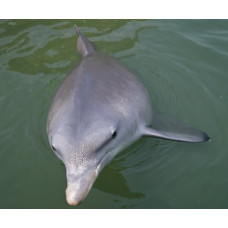Latin name
Sousa chinensis
Other name
Chinese white dolphin
Identification
The Indo-Pacific humpback dolphin has a strong, stocky body. The eyes are relatively small. Fins and pectoral fins are broad with rounded ends. The beak is long (about 6-10% of total length).
Features of fish fins
The dorsal fin and hump of the Indo-Pacific humpback dolphin vary between geographical regions. The dorsal fin is short and set on a broad base that gradually merges with the body in eastern dolphins. The tip of the fin is slightly curved backwards and the hump is small compared to the length of the body. In western waters, the dorsal fin is shorter and more curved backwards, but it sits on a much broader and longer base.
Fish colouring
Adult dolphins are grey, white or pink in colour and can appear albino. Populations with pink skin have been observed off the coast of China and Thailand. The pink colour is not due to pigmentation but to overdeveloped blood vessels for thermoregulation. Juveniles are dark grey or black at birth and measure about 1 m in length. As they grow older, their colouring becomes lighter and mottled grey.
Distribution
Indo-Pacific humpback dolphins are found in the Indian and Pacific Oceans, from the coast of Africa to the coast of China and Australia, mainly in the waters off the north and southeast of Lantau, Soko and Peng Chau Islands.
Habitat
Indo-Pacific humpback dolphins live in the tropics and subtropics. They live in warm waters, usually above 15 degrees Celsius, at an average depth of 20 metres, rarely venturing deeper than 25 metres. They are often found in bays, estuaries, mangrove forests, sandbanks, rocky and coral reefs and in or near the mouths of large rivers. They usually stay close to the shore, but sometimes go further out if the water depth remains shallow.
Size
The body length of these dolphins ranges from 2 to 3.5 m (7 to 11 ft) for adults and 1 m (3 ft) for juveniles. An adult weighs 150 to 230 kg (330 to 510 lb). Males are slightly larger than females. They live up to 40 years, according to analysis of their teeth.
Behavior
Indo-Pacific humpback dolphins live in small groups, usually no more than ten individuals, and hunt using echolocation. Adult dolphins surface to breathe for 20-30 seconds and then dive back into the water for two to eight minutes. Baby dolphins, which have smaller lung volumes, surface twice as often as adults and stay underwater for one to three minutes. Adult dolphins rarely stay underwater for more than four minutes. Sometimes they will jump out of the water completely. They can also rise vertically out of the water, exposing the dorsal part of their body. A pair of bulging eyes allows them to see well in both air and water.
Food and feeding habits
Indo-Pacific humpback dolphins feed mainly on fish. They usually do this near the bottom of the ocean. Some groups feed at high tide. These dolphins have been known to follow trawlers and feed on discarded organisms.
Reproduction
Female dolphins reach sexual maturity at around ten years of age, and males at around 13 years. They usually mate from late summer to autumn, and calves are born after a gestation period of eleven months. The mother stays with her calves until they are able to forage on their own, usually at the age of 3-4 years.
Fishing
These dolphins are occasionally hunted by humans, but not on a commercial scale. The Indo-Pacific humpback dolphin is threatened by habitat loss, water pollution, coastal development, overfishing and increased shipping throughout its range.
Relationship with a person
Boat trips to see these dolphins have been organised in Hong Kong since the 1990s. They are not usually kept in aquariums due to the high mortality rate in captivity.
| Classification | |
| Phylum | Chordata |
| Class | Mammalia |
| Squad | Artiodactyla |
| Family | Delphinidae |
| Genus | Sousa |
| Species | S. chinensis |
| Features | |
| Conservation status | Vulnerable |
| Habitat | Pelagic |
| Life span, years | 40 |
| Maximum body weight, kg | 230 |
| Maximum length, cm | 350 |
| Sailing speed, m/s | No information |
| Threat to people | Edible |
| Way of eating | Predator |


